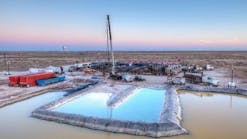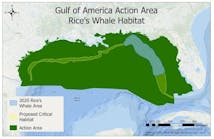Offshore Petroleum Operations OGJ SPECIAL Gulf of Mexico platform operators cope with abandonment issues
Guntis Moritis
Production Editor
Although abandonments continue, the Gulf of Mexico is seeing significant new activity. Seen here at Ingleside, Tex., are Shell Offshore Inc.'s Mars TLP for 2,945 ft of water, and, in front, Phillips Petroleum Co.'s jacket for the Mahogany discovery, the first subsalt play that will be put on production.
Removing offshore facilities has become a significant part of oil and gas operations in the U.S. outer continental shelf (OCS) of the Gulf of Mexico, a mature producing area.
Not including future platforms, removal of existing structures might cost the industry between $1.4 and 3.3 billion, depending on the removal methods permitted.
In every year since 1988, about 100 oil and gas platforms have been abandoned and removed in the Gulf of Mexico. In 1994, the number jumped to 181; however, in the last 2 years the number again has decreased to about 100/year. In 3 out of the last 5 years, more platforms and structures were abandoned than were installed (Fig. 1 [56161 bytes]).
Through 1995, the U.S. Minerals Management Service (MMS) records show that 1,363 platforms have been removed. The first was in 1973.
About 3,800 structures remain in the OCS of the Gulf of Mexico. Another 900-1,000 are in shallow state-controlled waters that are not included in MMS OCS statistics.
The OCS producing structures vary from simple shallow-water caissons to the tension-legged platform Mars, being installed in 2,945 ft of water (Fig. 2 [40208 bytes]). The deepest conventional fixed platform is Shell Offshore Inc.'s Bullwinkle in 1,350 ft of water.
The MMS requires platform removal within 1 year after termination of a lease.
Future prospects
Although platforms are being abandoned at a steady clip, this does not mean that Gulf of Mexico production will decrease soon. New plays such as subsalt and deepwater are expected to boost production in the future.
Shell has estimated that its deepwater projects alone will have a daily production of over 600,000 bbl of oil equivalent by 2000. From all operators, current Gulf of Mexico OCS production is about 1 million b/d of oil and condensate and 14 bcfd of gas.
MMS estimates that remaining proved reserves in 743 active fields in federal waters at the beginning of 1995 were 2.52 billion bbl of crude and condensate and 29.3 tcf of gas out of the original in place of 11.86 billion bbl and 141.9 tcf in 876 fields. A total of 133 fields have been depleted and abandoned.
Abandonment process
Requirements for protecting the environment and fisheries complicate platform abandonment procedures. A typical abandonment can include work such as:
- Surveying debris
- Diving
- Removing pipelines
- Plugging and abandoning wells
- Severing piles and conductors
- Decommissioning facilities
- Removing platforms
- Trawling for debris
- Selling of salvaged material
- Disposing of structures as an artificial reef
- Obtaining appropriate permits and submitting required reports
- Arranging for a National Marine Fisheries observer on board.
A current controversy surrounding platform abandonment involves using explosives to sever fixed structures. Currently, about two-thirds (Fig. 3 [44012 bytes]) of all platforms abandoned are removed with explosives. For platforms in more than 150 ft of water this number jumps to 90-95%.
Mechanical cutters work, but are said to be troublesome. Failures are a problem. Blades dull, and it is difficult to get back on a previous cut. Diver safety is another major consideration in mechanical cutters or using torches.
In 1994, the U.S. General Accounting Office, published a report concluding that MMS regulations were discouraging nonexplosive methods that would be less destructive on fish populations.
In response, MMS requested the National Research Council to study the problem. In the article that follows, Pulsipher, et al., discuss the 1996 NRC's Marine Board conclusion that for most Gulf of Mexico platform abandonments, explosives are both more economical and safer than other currently available methods for severing fixed structures.
The effect of explosives on fish populations is still under study, and MMS indicates that results may be available in June.
For another view, the accompanying box shows Unocal's perspective on abandonment issues.
The Marine Board committee's report says that new techniques are being developed for platform removal, but all need further development to determine their feasibility and cost effectiveness offshore. These methods include such technology as:
- Laser cutting
- Pyrotechnic cutting
- Cryogenics
- Chemical cutters
- Cutting with remote-operated vehicles
- Bubble curtains to attenuate the blast pressure
- Acoustic devices to keep fish away from platforms
- Incorporation in the original platform design easier ways to remove the structure.
Platform disposal
Once a fixed structure is severed it can be taken to shore for scrapping or refurbishment. But with appropriate permits and economics, the structure also can be toppled in place or sent to another location to form an artificial reef.
Unlike the controversial ocean disposal of Shell's Brent Spar in the North Sea, Gulf of Mexico structures have not been used for oil storage and, therefore, can be regarded as clean. Most environmentalists, government agencies, and fisherman support disposal of platforms to form artificial reefs.
Smaller structures are not appropriate for reefs. One breakdown shows that as deeper water structures are removed, a greater percentage of them are being included in the rigs-to-reefs programs as follows:
- In less than 20 ft of water, none of the 168 removed structures were converted to reefs.
- From 20 to 100 ft of water, 7 of 753 removed platforms formed reefs.
- From 100 to 200 ft of water, 63 of 152 removed platforms formed reefs.
- From 200 to 400 ft of water, 32 of 38 removed platforms formed reefs.
No structures have been removed in over 400 ft of water.
The industry hopes that more reef sites will be created so that platforms do not have to be transported long distances for disposal.
The most active programs are offshore Texas and Louisiana.
Texas reefs
Fig. 5 [112528 bytes] shows the artificial reefs off Texas. The first reefs in the 1960s-1980s were concrete pipes, barges, and World War II Liberty ships.
The first platform offshore Texas converted to an artificial reef was Transco Corp.'s four-pile platform at High Island A-492 in 195 ft of water. Transco signed the deed of donation on Jan. 1, 1990.
Since then, through March 1996, 36 structures have been donated and $3.8 million in contributions for maintenance have been received by Texas.
Two recent platforms made into reefs were the Union Pacific Resources Co. North Padre Island A-58 four-pile jacket in 252-ft of water and Oxy USA Inc.'s High Island A-355 eight-pile jacket in 305 ft of water. Each of these structures had only the top portion of the jacket severed. The remainder of the structure was left in intact.
Union Pacific's platform was cut at -86 ft and Oxy's at -91 ft.
As platforms are abandoned in deeper water, having the flexibility of only partially removing the structure can significantly reduce abandonment costs. The Marine Board report on abandonment does point out that shrimpers are the primary opponents of partial removals in water shallower than 300 ft. Shrimpers fear a decrease in trawlable waters.
Partial removals can also eliminate many of the liabilities of leaving the structure abandoned as is. Although in certain instances, liabilities might be eliminated by turning the entire structure over to oceanographic research institutions.
Louisiana program
In Louisiana, nine main sites for reef disposal have been created (Fig. 5 [112528 bytes]). These sites cover about a 3 x 6 block area. Some already have on the site as many as eight abandoned structures and most have at least one abandoned structure.
From the program's beginning in 1986 until March 1996, Louisiana has allowed 58 structures to be disposed of in its rigs-to-reef program.
About $7 million has been contributed to the maintenance program that is used as a model for other states. In this program, the operator donates to the state 50% of the costs saved by converting the platform structure to a reef. The states use the money for long-term reef maintenance such as expenses for marker buoys and monitoring.
The state assumes all liabilities for the reef. Copyright 1996 Oil & Gas Journal. All Rights Reserved.


